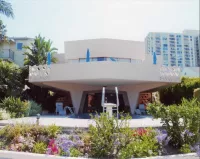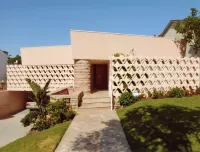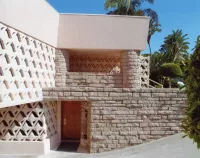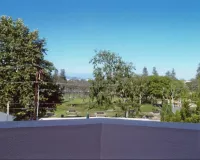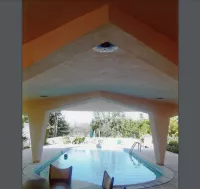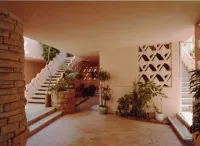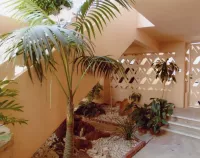Share what you know,
and discover more.
Share what you know,
and discover more.
Dec 22, 2011
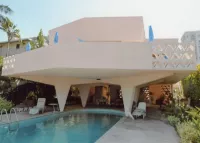
-

- Charmaine Bantugan
Karasik House - National Register of Historic Places
Statement of Significance: The Karasik House is eligible for the National Register of Historic Places under Criterion C at the local level of significance as an excellent example of Wrightian architecture. The period of significance for the Karasik House is the date of construction in 1960. The Karasik House was designed for Jacob and Sofia Karasik by Frank Lloyd Wright, Jr., better known as Lloyd Wright. Lloyd, like his father, spent much of his career pioneering an aesthetic vocabulary and experimenting with materials in search of an American architecture. His contributions to American architecture are significant not only locally, but also on a national level. The Karasik House is a typical example of Lloyd Wright’s more mannered and expressionist work of the 1950s and 60s. The house exemplifies Lloyd Wright’s life-long concern for integration of the building and its site, and his desire to blur the distinction between interior and exterior space. Before Lloyd Wright worked on the design for the Karasik House, a previous architect had come up with a design for a four-level house on the steep, narrow site. ® The Karasiks wanted the main living spaces to be on one floor, a difficult task considering the site topography and the fact that the family had four children. Jacob Karasik, a builder by profession, was referred to Lloyd Wright and hired him after a meeting in 1959. ^ Lloyd’s drawings are dated January 18,1960. Construction commenced later that year, with Jacob as the contractor. While the structure was largely completed long before, some finish work was still being completed four years later. ® The main house and pool deck were completed per Lloyd Wright’s original design. In fact, the original rendering of the house by Lloyd Wright still hangs on the wall of Jacob Karasik’s office, and the drawings are stored in the plan files originally designed by Wright. The Karasiks currently reside in the house, and keep the building well-maintained. History of Lloyd Wright (Frank Lloyd Wright Jr.) Lloyd Wright’s career is most commonly evaluated in reference to his father, Frank Lloyd Wright, “who has been generally acknowledged as America’s greatest architect.’’® “Though substantially more productive and, arguably, equally as creative in Los Angeles... [Lloyd] really never could disassociate himself professionally from his father.”’® Commonly, Lloyd Wright’s work has been described as “not startlingly original... highly derivative of his father’s style”” and “an extension of and variation on the work of [his] father.”’^ Though the younger Wright’s career was overshadowed by his father’s, Lloyd was a “world-renowned architect in his own right” and “played an important, if not starring, role in the period of Los Angeles history that saw the spread of modern architecture and the development of the motion picture as a cultural force in the city.”’® Because Lloyd shared an ideology, aesthetic, and name with his father, the uniqueness of his work is often overlooked. However, in contrast to the elder Wright, Lloyd displayed a distinctly innovative, theatrical flair, and his body of work can be seen as an original thesis on the ideal California Home. As Eric Lloyd Wright stated, “my father’s work was not imitative. I know my father wanted very badly to be remembered as an architect in his own right. Born on March 31,1890 in Oak Park, Illinois, Lloyd Wright experienced a childhood in some ways similar to his father’s. As Harriette Von Breton states, “He was nurtured in an environment designed by his father... received his primary and high school education from many of the same aunts and uncles who also taught his father -in the same environment that shaped his father... It is little wonder that the son reflects the father in so many ways.”’® Like his father, Lloyd’s childhood education included Friedrich Froebel’s geometric exercises, and an emphasis on music. In 1907, Lloyd followed in his father’s footsteps and enrolled in the University of Wisconsin at Madison, studying Engineering and Agronomy. In September 1909, Lloyd’s father announced his decision to abandon his home with his mistress Mamah Cheney, stating he was “deserting my wife and children for one year, in search of a spiritual adventure.”’^ Lloyd, nineteen years old at the time, knocked his father to the floor. However, as his father worked in Berlin on the Wasmuth Portfolio later in 1909, Lloyd withdrew from school and joined his father to help prepare drawings.’® Lloyd, interested in landscape design, returned to the US and became a draftsman in the office of the Olmstead brothers. In 1911, Lloyd moved to San Diego to work in the Olmstead’s’ nursery, and then entered Irving Gill’s office in 1912. Gill had been a fellow apprentice of Frank Lloyd Wright’s in Louis Sullivan’s Chicago office in the early 1890s. In 1915, Lloyd moved to Los Angeles to join Gill and Olmstead in development of a plan for the city of Torrance. Thus, Lloyd Wright’s career was not only influenced by his father’s work, but continues from a long line of American masters. In addition, his work as a landscape designer influenced Lloyd’s approach to architecture, as his projects often originate from a thoughtful integration of building and site. For Lloyd, “the building, the exterior retaining walls and stairs, the fountains and pools, together with the trees and other plants, form a complete tightly knit whole, and that part of the scheme made up of the four walls and roof was not enough to stand on its own.” In 1916, Lloyd opened his own office and began to design motion picture sets at Paramount Studios. He then married and briefly moved to New York as an airplane designer. In 1919, he returned to Los Angeles to work with his father on the Barnsdall project (Hollyhock House). ’ It was at this point where Frank Lloyd Wright’s presence once again became the dominant element in Lloyd’s life and Lloyd’s career became much more about architecture as opposed to landscape architecture. As David Gebhard states, “with his father in Los Angeles, the only real choice was architecture.”®® Thus “Lloyd’s intense relationship with FLW and his work would, with varying results, mark his own architecture as it developed in the 1920s.”®® During the 20s, in addition to his collaborations with his father, Lloyd Wright was well-known for his own dramatic house designs, and the designs for the first two shells of the Hollywood Bowl, the second of which “was an acoustical success, copied the world over.”® Though Lloyd was successful in creating innovative, dramatic architectural works, he still faced obscurity in comparison with his father. For example, it is a little-known fact that Lloyd’s first house, for Henry Bollman, is “a concrete-block structure that actually predates the far more celebrated group of concrete-block houses done by Frank Lloyd Wright in Los Angeles in the 1920’s.” Lloyd’s career In Los Angeles is of great significance, and much of his work has been recognized by the National Register. A few examples of listed properties are Lloyd’s own studio in West Hollywood, the Derby House in Glendale, the Sowden House in Los Angeles, and the Wayfarer’s Chapel in Portuguese Bend. Apparent in these works is Lloyd’s conception of the California House, a fortress-like form that totally protects inhabitants from trespass from the outside world, instead enclosing a court or garden where the Southern California lifestyle can be experienced in open privacy.®® “Compared to his father, Lloyd not only understood what could be done with vegetation and its relationship to a building in California, he was also much more receptive to the opening up of the interior space to be out-of-doors.” This blurring of interior and exterior space is part of the legacy of modern architecture in Southern Californian, and one which Lloyd Wright helped to pioneer. In the rich avant-garde architectural environment of twentieth-century Southern California, Lloyd Wright “explored the fertile intersection of modernism and regionalism."^® Lloyd’s evocative courtyard houses were a direct result of place, their forms inspired by the climate of Southern California, with a vocabulary that related directly to the American character. Like his father, Lloyd “related that his effort... was to establish a link and a continuity with that which was architecturally indigenous to America.”^® Lloyd inherited his father’s ideals and his tastes for “Oriental rugs, Japanese prints, the Arts and Crafts movement, and the pre-Columbian Mexican and Southwestern American Indian culture.’’®® The knit-block houses were one physical embodiment of this “indigenous” regionalism, and appealed to the Wrights’ aesthetic. Decorative, modular concrete elements became a recurring theme in Lloyd’s work, a theme continued with his design for the Karasik House. Lloyd’s Los Angeles houses “epitomized his talent for merging his own brand of Expressionism... with his and his father’s interest in Southwest Indian cultures. Lloyd Wright “never denied that he owed the best of himself to the strong genetic and cultural influences of the indomitable Frank Lloyd Wright.” As Thomas Hines summarized, “Lloyd Wright was, in a sense, a tragic figure, caught throughout his career in the shadow of his superhuman father. Both blessed and cursed by that paradoxical relationship, he nevertheless created, in his own truncated oeuvre, architectural marvels both on paper and on the land. Karasik Hous The Karasik House is an excellent example of Lloyd Wright’s Post-World War II work. Lloyd Wright’s expressive work of the 1950s and 60s was characterized by his buildings’ “oblique wall angles, mannered spatial configurations, and, especially, sweeping roofs. These houses seemed to suggest a marriage of space projectiles and large, handsome insects.” ^ During these later years, Lloyd Wright was “an unabashed mannerist, pushing, pulling, and breaking the 'rules’ of rational systems of proportion.” David Gebhard describes Wright’s work as Expressionist because of the following qualities: “first, the use of unconventional angled wall surfaces and details; second, the handling of these to create surfaces and volumes which are obviously meant to be read as existing ends in themselves; finally the buildings suggest a mysterious, unreal quality.” The qualities listed above—^with the sweeping roof motif transformed into the seemingly gravity defying rear deck—are exemplified by the Karasik House. Spaces are clearly subjected to the mannered angles of the plan, and architectural detailing is used to reinforce the angular motif of the floor plan, from the scale of the exterior elevations down to the detailing of light coves and furniture. The description of the building as a spacecraft or insect is clearly relevant to the Karasik House’s rear elevation, as the hovering body of the house juts over the landscape, supported by two tapered legs. In contrast to the rear, the front elevation of the Karasik House conveys a much more earth-bound imagery that bears the mannered tendencies of Lloyd Wright. David Gebhard describes the aggressiveness of the front elevation of the Karasik House as “agitated, flamboyant and anything but quiet... [the] domestic single family [equivalent] to the sparkling and tensely world of Wilshire Blvd.”®® Approaching the Karasik House on Spalding Drive, the home makes an impressive statement in contrast with its quiet, more traditional neighbors. The Karasik House exemplifies the attention to landscape and site design found in all of Lloyd Wright’s work. Sculpting the site to his needs, Wright skillfully connects the building and its site through the section, integrating the topography and site work into the building design. Even the planting was designed by Lloyd Wright, and some of the original plants still exist at the house.^® A courtyard at the center of the plan is a prominent feature of the Karasik House, and is typical of Wright’s Southern California houses. Throughout Lloyd Wright’s career, the courtyard was “the dominant element in a majority of his designs.’’®® Like the Sowden and Derby Houses, the Karasik House’s mysterious, fortress-like exterior is contrasted by the private open space of the courtyard. Around the Karasik House courtyard, Wright organized the upper-level circulation as well as using it as vertical circulation to the lower level. In the Karasik House, the exterior is a constant presence. In some cases, surfaces act as filters between interior and exterior as Wright plays with the contradiction of mass and transparency. Wright achieves this through the use of concrete screens, which were a technique first used at the Derby House, and then for his own Studio-Residence. The screens display a decorative motif custom-designed for the Karasik family. Functionally, the screens offer privacy from the street on the west elevation while also screening service spaces from view. For example, the kitchen is screened from the courtyard by the concrete lattice, which is placed on the exterior side of a frame-glazed window, presenting a decorative surface on the public side of the wall, while allowing light to penetrate the interior. Another play of transparency and mass can be seen where Wright designed Pyrex inserts in the massive courtyard stone wall. Unlike the Derby House and Wright’s Studio-Residence, the Karasik House’s modular concrete elements are limited to only a screen application, whereas Lloyd’s earlier works contained concrete blocks for both solid and transparent decorative elements. The Karasik House exterior recalls the Derby House, as planes of concrete screens interplay with planar stucco walls. As Susan Vaughn describes the Derby House: “The house’s paradoxical qualities—massive but airy, organic but otherworldly, simply contoured but elementally complex—make it a delight to behold.’’ House, though the two were built 34 years apart. The materials found at the Karasik House are all materials typically used by Lloyd Wright. Even the pinkish color of the stone and stucco exterior is found repeatedly in his work. Although the exterior has been repainted, the original color of the house was similar. The stone and stucco material choices speak to his and his father’s wish “to create... [an] indigenous ’primitive’ feeling in their California architecture, by using a material which [comes] close in feeling to adobe and stone and the lime cement structures erected by the Mayas. Because of the expense of concrete, Lloyd used it sparingly as decorative elements, and turned to stucco on wood framing as a cost-effective alternative.''® Even the materials used for the flat roof of the house has historic significance, as Wright “was one of the first to advocate and use crushed large aggregate lightweight pumice and crushed brick or tile for built-up roofs—something which today is a common Southern California practice.”''® Inside the home, the use of laminate, terrazzo, and wood are also very typical of Wright’s work. Comparing the Karasik House with the earlier Derby House, the interiors share a similar language of cantilevered plaster soffits trimmed in wood, intricately detailed wood light coves, and a continuation of exterior materials into the interior of the home. Fireplaces are a focal point, and opportunity to adorn the interior with the same materials found on the exterior of the home. Between the careful detailing of Wright and the skillfulness of the owner-builder, the craftsmanship found in the house is of the highest order. Especially notable are the meticulously scribed wood joints, as well as the stone and concrete work. The Karasik House reflects both Lloyd and his father’s dedication to the total design of an environment. On a larger scale, Lloyd created horizontal datum lines both on the exterior and the interior of the house, which reinforces the idea of a unified, cohesive environment. Further, horizontal detailing echoes the elongated building form and its relationship to the landscape. Wall surfaces are angular, both in plan and elevation, and this highly mannered design language is carried through to the level of details. For example, light coves, soffits, and built-in furniture reiterate the angular design of the whole. Typical of mid-century modern architecture, casework is fully integrated into the design, either concealed by touch latches or detailed to reflect the angular motif of the house.
Karasik House - National Register of Historic Places
Statement of Significance: The Karasik House is eligible for the National Register of Historic Places under Criterion C at the local level of significance as an excellent example of Wrightian architecture. The period of significance for the Karasik House is the date of construction in 1960. The Karasik House was designed for Jacob and Sofia Karasik by Frank Lloyd Wright, Jr., better known as Lloyd Wright. Lloyd, like his father, spent much of his career pioneering an aesthetic vocabulary and experimenting with materials in search of an American architecture. His contributions to American architecture are significant not only locally, but also on a national level. The Karasik House is a typical example of Lloyd Wright’s more mannered and expressionist work of the 1950s and 60s. The house exemplifies Lloyd Wright’s life-long concern for integration of the building and its site, and his desire to blur the distinction between interior and exterior space. Before Lloyd Wright worked on the design for the Karasik House, a previous architect had come up with a design for a four-level house on the steep, narrow site. ® The Karasiks wanted the main living spaces to be on one floor, a difficult task considering the site topography and the fact that the family had four children. Jacob Karasik, a builder by profession, was referred to Lloyd Wright and hired him after a meeting in 1959. ^ Lloyd’s drawings are dated January 18,1960. Construction commenced later that year, with Jacob as the contractor. While the structure was largely completed long before, some finish work was still being completed four years later. ® The main house and pool deck were completed per Lloyd Wright’s original design. In fact, the original rendering of the house by Lloyd Wright still hangs on the wall of Jacob Karasik’s office, and the drawings are stored in the plan files originally designed by Wright. The Karasiks currently reside in the house, and keep the building well-maintained. History of Lloyd Wright (Frank Lloyd Wright Jr.) Lloyd Wright’s career is most commonly evaluated in reference to his father, Frank Lloyd Wright, “who has been generally acknowledged as America’s greatest architect.’’® “Though substantially more productive and, arguably, equally as creative in Los Angeles... [Lloyd] really never could disassociate himself professionally from his father.”’® Commonly, Lloyd Wright’s work has been described as “not startlingly original... highly derivative of his father’s style”” and “an extension of and variation on the work of [his] father.”’^ Though the younger Wright’s career was overshadowed by his father’s, Lloyd was a “world-renowned architect in his own right” and “played an important, if not starring, role in the period of Los Angeles history that saw the spread of modern architecture and the development of the motion picture as a cultural force in the city.”’® Because Lloyd shared an ideology, aesthetic, and name with his father, the uniqueness of his work is often overlooked. However, in contrast to the elder Wright, Lloyd displayed a distinctly innovative, theatrical flair, and his body of work can be seen as an original thesis on the ideal California Home. As Eric Lloyd Wright stated, “my father’s work was not imitative. I know my father wanted very badly to be remembered as an architect in his own right. Born on March 31,1890 in Oak Park, Illinois, Lloyd Wright experienced a childhood in some ways similar to his father’s. As Harriette Von Breton states, “He was nurtured in an environment designed by his father... received his primary and high school education from many of the same aunts and uncles who also taught his father -in the same environment that shaped his father... It is little wonder that the son reflects the father in so many ways.”’® Like his father, Lloyd’s childhood education included Friedrich Froebel’s geometric exercises, and an emphasis on music. In 1907, Lloyd followed in his father’s footsteps and enrolled in the University of Wisconsin at Madison, studying Engineering and Agronomy. In September 1909, Lloyd’s father announced his decision to abandon his home with his mistress Mamah Cheney, stating he was “deserting my wife and children for one year, in search of a spiritual adventure.”’^ Lloyd, nineteen years old at the time, knocked his father to the floor. However, as his father worked in Berlin on the Wasmuth Portfolio later in 1909, Lloyd withdrew from school and joined his father to help prepare drawings.’® Lloyd, interested in landscape design, returned to the US and became a draftsman in the office of the Olmstead brothers. In 1911, Lloyd moved to San Diego to work in the Olmstead’s’ nursery, and then entered Irving Gill’s office in 1912. Gill had been a fellow apprentice of Frank Lloyd Wright’s in Louis Sullivan’s Chicago office in the early 1890s. In 1915, Lloyd moved to Los Angeles to join Gill and Olmstead in development of a plan for the city of Torrance. Thus, Lloyd Wright’s career was not only influenced by his father’s work, but continues from a long line of American masters. In addition, his work as a landscape designer influenced Lloyd’s approach to architecture, as his projects often originate from a thoughtful integration of building and site. For Lloyd, “the building, the exterior retaining walls and stairs, the fountains and pools, together with the trees and other plants, form a complete tightly knit whole, and that part of the scheme made up of the four walls and roof was not enough to stand on its own.” In 1916, Lloyd opened his own office and began to design motion picture sets at Paramount Studios. He then married and briefly moved to New York as an airplane designer. In 1919, he returned to Los Angeles to work with his father on the Barnsdall project (Hollyhock House). ’ It was at this point where Frank Lloyd Wright’s presence once again became the dominant element in Lloyd’s life and Lloyd’s career became much more about architecture as opposed to landscape architecture. As David Gebhard states, “with his father in Los Angeles, the only real choice was architecture.”®® Thus “Lloyd’s intense relationship with FLW and his work would, with varying results, mark his own architecture as it developed in the 1920s.”®® During the 20s, in addition to his collaborations with his father, Lloyd Wright was well-known for his own dramatic house designs, and the designs for the first two shells of the Hollywood Bowl, the second of which “was an acoustical success, copied the world over.”® Though Lloyd was successful in creating innovative, dramatic architectural works, he still faced obscurity in comparison with his father. For example, it is a little-known fact that Lloyd’s first house, for Henry Bollman, is “a concrete-block structure that actually predates the far more celebrated group of concrete-block houses done by Frank Lloyd Wright in Los Angeles in the 1920’s.” Lloyd’s career In Los Angeles is of great significance, and much of his work has been recognized by the National Register. A few examples of listed properties are Lloyd’s own studio in West Hollywood, the Derby House in Glendale, the Sowden House in Los Angeles, and the Wayfarer’s Chapel in Portuguese Bend. Apparent in these works is Lloyd’s conception of the California House, a fortress-like form that totally protects inhabitants from trespass from the outside world, instead enclosing a court or garden where the Southern California lifestyle can be experienced in open privacy.®® “Compared to his father, Lloyd not only understood what could be done with vegetation and its relationship to a building in California, he was also much more receptive to the opening up of the interior space to be out-of-doors.” This blurring of interior and exterior space is part of the legacy of modern architecture in Southern Californian, and one which Lloyd Wright helped to pioneer. In the rich avant-garde architectural environment of twentieth-century Southern California, Lloyd Wright “explored the fertile intersection of modernism and regionalism."^® Lloyd’s evocative courtyard houses were a direct result of place, their forms inspired by the climate of Southern California, with a vocabulary that related directly to the American character. Like his father, Lloyd “related that his effort... was to establish a link and a continuity with that which was architecturally indigenous to America.”^® Lloyd inherited his father’s ideals and his tastes for “Oriental rugs, Japanese prints, the Arts and Crafts movement, and the pre-Columbian Mexican and Southwestern American Indian culture.’’®® The knit-block houses were one physical embodiment of this “indigenous” regionalism, and appealed to the Wrights’ aesthetic. Decorative, modular concrete elements became a recurring theme in Lloyd’s work, a theme continued with his design for the Karasik House. Lloyd’s Los Angeles houses “epitomized his talent for merging his own brand of Expressionism... with his and his father’s interest in Southwest Indian cultures. Lloyd Wright “never denied that he owed the best of himself to the strong genetic and cultural influences of the indomitable Frank Lloyd Wright.” As Thomas Hines summarized, “Lloyd Wright was, in a sense, a tragic figure, caught throughout his career in the shadow of his superhuman father. Both blessed and cursed by that paradoxical relationship, he nevertheless created, in his own truncated oeuvre, architectural marvels both on paper and on the land. Karasik Hous The Karasik House is an excellent example of Lloyd Wright’s Post-World War II work. Lloyd Wright’s expressive work of the 1950s and 60s was characterized by his buildings’ “oblique wall angles, mannered spatial configurations, and, especially, sweeping roofs. These houses seemed to suggest a marriage of space projectiles and large, handsome insects.” ^ During these later years, Lloyd Wright was “an unabashed mannerist, pushing, pulling, and breaking the 'rules’ of rational systems of proportion.” David Gebhard describes Wright’s work as Expressionist because of the following qualities: “first, the use of unconventional angled wall surfaces and details; second, the handling of these to create surfaces and volumes which are obviously meant to be read as existing ends in themselves; finally the buildings suggest a mysterious, unreal quality.” The qualities listed above—^with the sweeping roof motif transformed into the seemingly gravity defying rear deck—are exemplified by the Karasik House. Spaces are clearly subjected to the mannered angles of the plan, and architectural detailing is used to reinforce the angular motif of the floor plan, from the scale of the exterior elevations down to the detailing of light coves and furniture. The description of the building as a spacecraft or insect is clearly relevant to the Karasik House’s rear elevation, as the hovering body of the house juts over the landscape, supported by two tapered legs. In contrast to the rear, the front elevation of the Karasik House conveys a much more earth-bound imagery that bears the mannered tendencies of Lloyd Wright. David Gebhard describes the aggressiveness of the front elevation of the Karasik House as “agitated, flamboyant and anything but quiet... [the] domestic single family [equivalent] to the sparkling and tensely world of Wilshire Blvd.”®® Approaching the Karasik House on Spalding Drive, the home makes an impressive statement in contrast with its quiet, more traditional neighbors. The Karasik House exemplifies the attention to landscape and site design found in all of Lloyd Wright’s work. Sculpting the site to his needs, Wright skillfully connects the building and its site through the section, integrating the topography and site work into the building design. Even the planting was designed by Lloyd Wright, and some of the original plants still exist at the house.^® A courtyard at the center of the plan is a prominent feature of the Karasik House, and is typical of Wright’s Southern California houses. Throughout Lloyd Wright’s career, the courtyard was “the dominant element in a majority of his designs.’’®® Like the Sowden and Derby Houses, the Karasik House’s mysterious, fortress-like exterior is contrasted by the private open space of the courtyard. Around the Karasik House courtyard, Wright organized the upper-level circulation as well as using it as vertical circulation to the lower level. In the Karasik House, the exterior is a constant presence. In some cases, surfaces act as filters between interior and exterior as Wright plays with the contradiction of mass and transparency. Wright achieves this through the use of concrete screens, which were a technique first used at the Derby House, and then for his own Studio-Residence. The screens display a decorative motif custom-designed for the Karasik family. Functionally, the screens offer privacy from the street on the west elevation while also screening service spaces from view. For example, the kitchen is screened from the courtyard by the concrete lattice, which is placed on the exterior side of a frame-glazed window, presenting a decorative surface on the public side of the wall, while allowing light to penetrate the interior. Another play of transparency and mass can be seen where Wright designed Pyrex inserts in the massive courtyard stone wall. Unlike the Derby House and Wright’s Studio-Residence, the Karasik House’s modular concrete elements are limited to only a screen application, whereas Lloyd’s earlier works contained concrete blocks for both solid and transparent decorative elements. The Karasik House exterior recalls the Derby House, as planes of concrete screens interplay with planar stucco walls. As Susan Vaughn describes the Derby House: “The house’s paradoxical qualities—massive but airy, organic but otherworldly, simply contoured but elementally complex—make it a delight to behold.’’ House, though the two were built 34 years apart. The materials found at the Karasik House are all materials typically used by Lloyd Wright. Even the pinkish color of the stone and stucco exterior is found repeatedly in his work. Although the exterior has been repainted, the original color of the house was similar. The stone and stucco material choices speak to his and his father’s wish “to create... [an] indigenous ’primitive’ feeling in their California architecture, by using a material which [comes] close in feeling to adobe and stone and the lime cement structures erected by the Mayas. Because of the expense of concrete, Lloyd used it sparingly as decorative elements, and turned to stucco on wood framing as a cost-effective alternative.''® Even the materials used for the flat roof of the house has historic significance, as Wright “was one of the first to advocate and use crushed large aggregate lightweight pumice and crushed brick or tile for built-up roofs—something which today is a common Southern California practice.”''® Inside the home, the use of laminate, terrazzo, and wood are also very typical of Wright’s work. Comparing the Karasik House with the earlier Derby House, the interiors share a similar language of cantilevered plaster soffits trimmed in wood, intricately detailed wood light coves, and a continuation of exterior materials into the interior of the home. Fireplaces are a focal point, and opportunity to adorn the interior with the same materials found on the exterior of the home. Between the careful detailing of Wright and the skillfulness of the owner-builder, the craftsmanship found in the house is of the highest order. Especially notable are the meticulously scribed wood joints, as well as the stone and concrete work. The Karasik House reflects both Lloyd and his father’s dedication to the total design of an environment. On a larger scale, Lloyd created horizontal datum lines both on the exterior and the interior of the house, which reinforces the idea of a unified, cohesive environment. Further, horizontal detailing echoes the elongated building form and its relationship to the landscape. Wall surfaces are angular, both in plan and elevation, and this highly mannered design language is carried through to the level of details. For example, light coves, soffits, and built-in furniture reiterate the angular design of the whole. Typical of mid-century modern architecture, casework is fully integrated into the design, either concealed by touch latches or detailed to reflect the angular motif of the house.
Dec 22, 2011
Karasik House - National Register of Historic Places
Statement of Significance:The Karasik House is eligible for the National Register of Historic Places under Criterion C at the local level of significance as an excellent example of Wrightian architecture. The period of significance for the Karasik House is the date of construction in 1960. The Karasik House was designed for Jacob and Sofia Karasik by Frank Lloyd Wright, Jr., better known as Lloyd Wright. Lloyd, like his father, spent much of his career pioneering an aesthetic vocabulary and experimenting with materials in search of an American architecture. His contributions to American architecture are significant not only locally, but also on a national level. The Karasik House is a typical example of Lloyd Wright’s more mannered and expressionist work of the 1950s and 60s. The house exemplifies Lloyd Wright’s life-long concern for integration of the building and its site, and his desire to blur the distinction between interior and exterior space.
Before Lloyd Wright worked on the design for the Karasik House, a previous architect had come up with a design for a four-level house on the steep, narrow site. ® The Karasiks wanted the main living spaces to be on one floor, a difficult task considering the site topography and the fact that the family had four children. Jacob Karasik, a builder by profession, was referred to Lloyd Wright and hired him after a meeting in 1959. ^ Lloyd’s drawings are dated January 18,1960. Construction commenced later that year, with Jacob as the contractor. While the structure was largely completed long before, some finish work was still being completed four years later. ® The main house and pool deck were completed per Lloyd Wright’s original design. In fact, the original rendering of the house by Lloyd Wright still hangs on the wall of Jacob Karasik’s office, and the drawings are stored in the plan files originally designed by Wright. The Karasiks currently reside in the house, and keep the building well-maintained.
History of Lloyd Wright (Frank Lloyd Wright Jr.)
Lloyd Wright’s career is most commonly evaluated in reference to his father, Frank Lloyd Wright, “who has been generally acknowledged as America’s greatest architect.’’® “Though substantially more productive and, arguably, equally as creative in Los Angeles... [Lloyd] really never could disassociate himself professionally from his father.”’® Commonly, Lloyd Wright’s work has been described as “not startlingly original... highly derivative of his father’s style”” and “an extension of and variation on the work of [his] father.”’^ Though the younger Wright’s career was overshadowed by his father’s, Lloyd was a “world-renowned architect in his own right” and “played an important, if not starring, role in the period of Los Angeles history that saw the spread of modern architecture and the development of the motion picture as a cultural force in the city.”’® Because Lloyd shared an ideology, aesthetic, and name with his father, the uniqueness of his work is often overlooked. However, in contrast to the elder Wright, Lloyd displayed a distinctly innovative, theatrical flair, and his body of work can be seen as an original thesis on the ideal California Home. As Eric Lloyd Wright stated, “my father’s work was not imitative. I know my father wanted very badly to be remembered as an architect in his own right.
Born on March 31,1890 in Oak Park, Illinois, Lloyd Wright experienced a childhood in some ways similar to his father’s. As Harriette Von Breton states, “He was nurtured in an environment designed by his father... received his primary and high school education from many of the same aunts and uncles who also taught his father -in the same environment that shaped his father... It is little wonder that the son reflects the father in so many ways.”’® Like his father, Lloyd’s childhood education included Friedrich Froebel’s geometric exercises, and an emphasis on music.
In 1907, Lloyd followed in his father’s footsteps and enrolled in the University of Wisconsin at Madison, studying Engineering and Agronomy. In September 1909, Lloyd’s father announced his decision to abandon his home with his mistress Mamah Cheney, stating he was “deserting my wife and children for one year, in search of a spiritual adventure.”’^ Lloyd, nineteen years old at the time, knocked his father to the floor. However, as his father worked in Berlin on the Wasmuth Portfolio later in 1909, Lloyd withdrew from school and joined his father to help prepare drawings.’®
Lloyd, interested in landscape design, returned to the US and became a draftsman in the office of the Olmstead brothers. In 1911, Lloyd moved to San Diego to work in the Olmstead’s’ nursery, and then entered Irving Gill’s office in 1912. Gill had been a fellow apprentice of Frank Lloyd Wright’s in Louis Sullivan’s Chicago office in the early 1890s. In 1915, Lloyd moved to Los Angeles to join Gill and Olmstead in development of a plan for the city of Torrance. Thus, Lloyd Wright’s career was not only influenced by his father’s work, but continues from a long line of American masters. In addition, his work as a landscape designer influenced Lloyd’s approach to architecture, as his projects often originate from a thoughtful integration of building and site. For Lloyd, “the building, the exterior retaining walls and stairs, the fountains and pools, together with the trees and other plants, form a complete tightly knit whole, and that part of the scheme made up of the four walls and roof was not enough to stand on its own.”
In 1916, Lloyd opened his own office and began to design motion picture sets at Paramount Studios. He then married and briefly moved to New York as an airplane designer. In 1919, he returned to Los Angeles to work with his father on the Barnsdall project (Hollyhock House). ’ It was at this point where Frank Lloyd Wright’s presence once again became the dominant element in Lloyd’s life and Lloyd’s career became much more about architecture as opposed to landscape architecture. As David Gebhard states, “with his father in Los Angeles, the only real choice was architecture.”®® Thus “Lloyd’s intense relationship with FLW and his work would, with varying results, mark his own architecture as it developed in the 1920s.”®® During the 20s, in addition to his collaborations with his father, Lloyd Wright was well-known for his own dramatic house designs, and the designs for the first two shells of the Hollywood Bowl, the second of which “was an acoustical success, copied the world over.”®
Though Lloyd was successful in creating innovative, dramatic architectural works, he still faced obscurity in comparison with his father. For example, it is a little-known fact that Lloyd’s first house, for Henry Bollman, is “a concrete-block structure that actually predates the far more celebrated group of concrete-block houses done by Frank Lloyd Wright in Los Angeles in the 1920’s.” Lloyd’s career In Los Angeles is of great significance, and much of his work has been recognized by the National Register. A few examples of listed properties are Lloyd’s own studio in West Hollywood, the Derby House in Glendale, the Sowden House in Los Angeles, and the Wayfarer’s Chapel in Portuguese Bend. Apparent in these works is Lloyd’s conception of the California House, a fortress-like form that totally protects inhabitants from trespass from the outside world, instead enclosing a court or garden where the Southern California lifestyle can be experienced in open privacy.®® “Compared to his father, Lloyd not only understood what could be done with vegetation and its relationship to a building in California, he was also much more receptive to the opening up of the interior space to be out-of-doors.” This blurring of interior and exterior space is part of the legacy of modern architecture in Southern Californian, and one which Lloyd Wright helped to pioneer.
In the rich avant-garde architectural environment of twentieth-century Southern California, Lloyd Wright “explored the fertile intersection of modernism and regionalism."^® Lloyd’s evocative courtyard houses were a direct result of place, their forms inspired by the climate of Southern California, with a vocabulary that related directly to the American character. Like his father, Lloyd “related that his effort... was to establish a link and a continuity with that which was architecturally indigenous to America.”^® Lloyd inherited his father’s ideals and his tastes for “Oriental rugs, Japanese prints, the Arts and Crafts movement, and the pre-Columbian Mexican and Southwestern American Indian culture.’’®® The knit-block houses were one physical embodiment of this “indigenous” regionalism, and appealed to the Wrights’ aesthetic. Decorative, modular concrete elements became a recurring theme in Lloyd’s work, a theme continued with his design for the Karasik House. Lloyd’s Los Angeles houses “epitomized his talent for merging his own brand of Expressionism... with his and his father’s interest in Southwest Indian cultures.
Lloyd Wright “never denied that he owed the best of himself to the strong genetic and cultural influences of the indomitable Frank Lloyd Wright.” As Thomas Hines summarized, “Lloyd Wright was, in a sense, a tragic figure, caught throughout his career in the shadow of his superhuman father. Both blessed and cursed by that paradoxical relationship, he nevertheless created, in his own truncated oeuvre, architectural marvels both on paper and on the land.
Karasik Hous
The Karasik House is an excellent example of Lloyd Wright’s Post-World War II work. Lloyd Wright’s expressive work of the 1950s and 60s was characterized by his buildings’ “oblique wall angles, mannered spatial configurations, and, especially, sweeping roofs. These houses seemed to suggest a marriage of space projectiles and large, handsome insects.” ^ During these later years, Lloyd Wright was “an unabashed mannerist, pushing, pulling, and breaking the 'rules’ of rational systems of proportion.” David Gebhard describes Wright’s work as Expressionist because of the following qualities: “first, the use of unconventional angled wall surfaces and details; second, the handling of these to create surfaces and volumes which are obviously meant to be read as existing ends in themselves; finally the buildings suggest a mysterious, unreal quality.”
The qualities listed above—^with the sweeping roof motif transformed into the seemingly gravity defying rear deck—are exemplified by the Karasik House. Spaces are clearly subjected to the mannered angles of the plan, and architectural detailing is used to reinforce the angular motif of the floor plan, from the scale of the exterior elevations down to the detailing of light coves and furniture. The description of the building as a spacecraft or insect is clearly relevant to the Karasik House’s rear elevation, as the hovering body of the house juts over the landscape, supported by two tapered legs. In contrast to the rear, the front elevation of the Karasik House conveys a much more earth-bound imagery that bears the mannered tendencies of Lloyd Wright. David Gebhard describes the aggressiveness of the front elevation of the Karasik House as “agitated, flamboyant and anything but quiet... [the] domestic single family [equivalent] to the sparkling and tensely world of Wilshire Blvd.”®® Approaching the Karasik House on Spalding Drive, the home makes an impressive statement in contrast with its quiet, more traditional neighbors.
The Karasik House exemplifies the attention to landscape and site design found in all of Lloyd Wright’s work. Sculpting the site to his needs, Wright skillfully connects the building and its site through the section, integrating the topography and site work into the building design. Even the planting was designed by Lloyd Wright, and some of the original plants still exist at the house.^® A courtyard at the center of the plan is a prominent feature of the Karasik House, and is typical of Wright’s Southern California houses. Throughout Lloyd Wright’s career, the courtyard was “the dominant element in a majority of his designs.’’®® Like the Sowden and Derby Houses, the Karasik House’s mysterious, fortress-like exterior is contrasted by the private open space of the courtyard. Around the Karasik House courtyard, Wright organized the upper-level circulation as well as using it as vertical circulation to the lower level.
In the Karasik House, the exterior is a constant presence. In some cases, surfaces act as filters between interior and exterior as Wright plays with the contradiction of mass and transparency. Wright achieves this through the use of concrete screens, which were a technique first used at the Derby House, and then for his own Studio-Residence. The screens display a decorative motif custom-designed for the Karasik family. Functionally, the screens offer privacy from the street on the west elevation while also screening service spaces from view. For example, the kitchen is screened from the courtyard by the concrete lattice, which is placed on the exterior side of a frame-glazed window, presenting a decorative surface on the public side of the wall, while allowing light to penetrate the interior. Another play of transparency and mass can be seen where Wright designed Pyrex inserts in the massive courtyard stone wall. Unlike the Derby House and Wright’s Studio-Residence, the Karasik House’s modular concrete elements are limited to only a screen application, whereas Lloyd’s earlier works contained concrete blocks for both solid and transparent decorative elements. The Karasik House exterior recalls the Derby House, as planes of concrete screens interplay with planar stucco walls. As Susan Vaughn describes the Derby House: “The house’s paradoxical qualities—massive but airy, organic but otherworldly, simply contoured but elementally complex—make it a delight to behold.’’ House, though the two were built 34 years apart.
The materials found at the Karasik House are all materials typically used by Lloyd Wright. Even the pinkish color of the stone and stucco exterior is found repeatedly in his work. Although the exterior has been repainted, the original color of the house was similar. The stone and stucco material choices speak to his and his father’s wish “to create... [an] indigenous ’primitive’ feeling in their California architecture, by using a material which [comes] close in feeling to adobe and stone and the lime cement structures erected by the Mayas. Because of the expense of concrete, Lloyd used it sparingly as decorative elements, and turned to stucco on wood framing as a cost-effective alternative.''® Even the materials used for the flat roof of the house has historic significance, as Wright “was one of the first to advocate and use crushed large aggregate lightweight pumice and crushed brick or tile for built-up roofs—something which today is a common Southern California practice.”''® Inside the home, the use of laminate, terrazzo, and wood are also very typical of Wright’s work. Comparing the Karasik House with the earlier Derby House, the interiors share a similar language of cantilevered plaster soffits trimmed in wood, intricately detailed wood light coves, and a continuation of exterior materials into the interior of the home. Fireplaces are a focal point, and opportunity to adorn the interior with the same materials found on the exterior of the home. Between the careful detailing of Wright and the skillfulness of the owner-builder, the craftsmanship found in the house is of the highest order. Especially notable are the meticulously scribed wood joints, as well as the stone and concrete work.
The Karasik House reflects both Lloyd and his father’s dedication to the total design of an environment. On a larger scale, Lloyd created horizontal datum lines both on the exterior and the interior of the house, which reinforces the idea of a unified, cohesive environment. Further, horizontal detailing echoes the elongated building form and its relationship to the landscape. Wall surfaces are angular, both in plan and elevation, and this highly mannered design language is carried through to the level of details. For example, light coves, soffits, and built-in furniture reiterate the angular design of the whole. Typical of mid-century modern architecture, casework is fully integrated into the design, either concealed by touch latches or detailed to reflect the angular motif of the house.
Posted Date
Mar 17, 2022
Historical Record Date
Dec 22, 2011
Source Name
United States Department of Interior - National Park Service
Source Website
Delete Story
Are you sure you want to delete this story?


